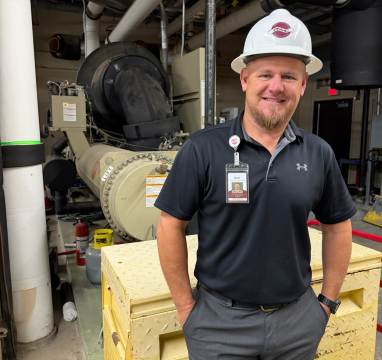Phelps Memorial is undertaking a significant infrastructure upgrade to its central chiller plant, a vital but often unseen system that keeps the hospital safe, comfortable, and fully operational every day. The project involves removing three existing chillers and four aging cooling towers, which will be replaced with two larger, more efficient chillers and two new cooling towers. Additionally, all associated pumps and piping that serve these systems will be replaced.
A chiller works much like a home air conditioner but on a much larger scale. It removes heat from water using refrigerant, producing chilled water that circulates through the hospital’s air handling units to provide cooling. The cooling tower serves as the outdoor component, dispersing that heat into the atmosphere before the cooled water returns to the chiller to repeat the process.
This project has been in development for several years as part of the hospital’s long-term infrastructure plan. It was originally planned during the 2019 Phelps Medical Group Clinic construction but was postponed due to budget constraints. The need for system redundancy, a requirement in healthcare facilities that operate 24/7, ultimately drove the decision to move forward now. Once complete, the system will ensure that if one chiller or cooling tower goes offline, others can maintain full operation. The project is expected to take approximately nine months.
“In healthcare, every critical system has to have redundancy,” said Matt Crooker, Director of Facilities. “We operate 24/7. There’s no option to shut down or pause for repairs. This project will allow us to care for our patients without interruption, even if one chiller or tower goes down.”
Hospitals can’t afford downtime, and this upgrade ensures continuous operation. Phelps Memorial requires only two chillers and one cooling tower for normal operation, leaving one additional chiller and tower as built-in redundancy. If a unit fails, maintenance staff can switch seamlessly to a backup without impacting hospital operations.
“The most likely failure would happen in the heat of summer,” Crooker explained. “In the past, if a chiller broke down, we’d have to shut down non-essential air handlers and focus all cooling on critical areas. That means some parts of the hospital would get extremely hot. With this project, that won’t happen — we’ll always have a backup ready.”
The new chillers incorporate magnetic bearing technology, replacing traditional mechanical bearings. This design eliminates friction and the need for lubrication, reducing energy consumption and maintenance requirements while improving long-term reliability. The result is a significant boost in energy efficiency and system performance.
Executing a project of this scale while keeping a hospital fully operational requires careful coordination between the facility and construction teams. Work will be completed in phases, ensuring that cooling capacity remains available at all times. This approach allows the hospital to continue daily operations without disruption to patient care or comfort.
While few will ever see the chiller plant in action, it remains one of the hospital’s most critical systems. As Crooker noted, “Without the infrastructure to support patient care, you don’t have a facility to take care of patients.” The multi-million-dollar investment reflects the hospital’s commitment to maintaining dependable systems that support patient care now and for years to come.



